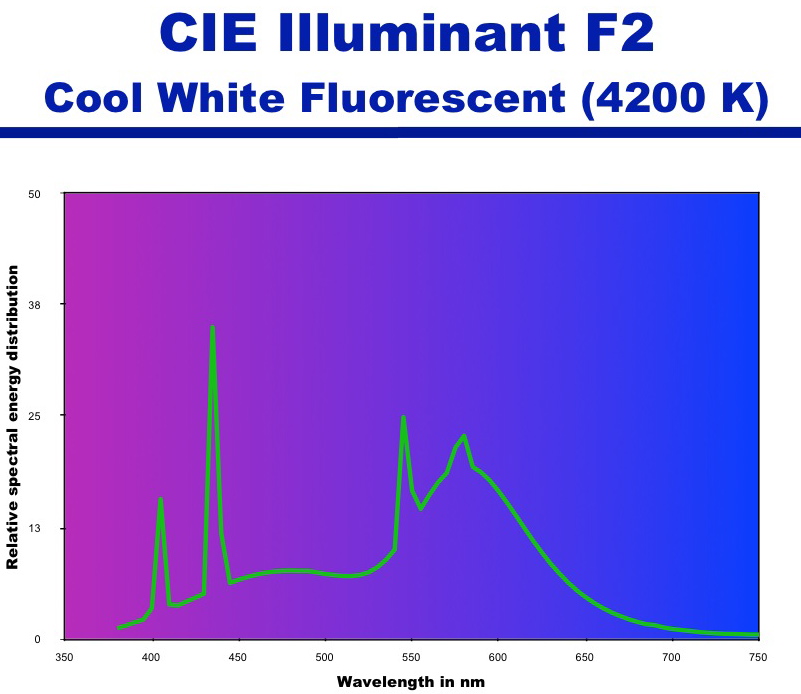Hi Rich,
Chose promise, chose due!
As you
know, daylight, which our brain interprets as colorless, actually contains
the whole spectrum of visible radiations between (roughly) wavelengths 390
nm and 700 nm (Fig 1)

When daylight hits our favorite Ersari,
its red dye absorbs selectively some wavelengths around 500 nm (Fig
2).

The
reflected light hitting our eye will not contain these absorbed wave
lengths and our brain will inform us that what we are looking at is
red.(Fig 3)

It is obvious that if a different
light hits the rug, for example a much bluer or much redder one, this will
impact both the absorbed and the reflected lights and therefore modify our
perception of the color of the rug (Photoshop docet).
Our eyes
& brains interpret several distributions of visible wavelengths
(various lights), as being colorless. We usually only differentiate them
as being «warmer» or «colder»
The illustrations show but two of them,
the «standard daylight» (Fig 4) and the «cool white fluorescent light»
(Fig 5).


We encounter many other
colorless lights in our daily life. The wavelength spectrum of a sunny day
differs from the one of a foggy day, bulb light differs from white neon
light etc. Since different colorless lights can have quite different
wavelength distribution it is rather logical that looking at a colored
material under such different lights will modify our perception of its
shade.
Now comes an important and perhaps not obvious point: Just
as various lights with significant different spectral distributions seem
«white» or colorless to us, textiles dyed with different dye mixes,
showing small, but significant differences in their reflectance curves,
can still be judged as having the same color by our imperfect eye &
brain tool, at least under a given light source.
For example the
two brown textiles below (Fig 6) have very similar shades under shop
window light, despite significantly different reflectance curves (Fig
7).


If we now look at our
two brown textiles under daylight the shades of both samples change, brown
1 goes massively greener and brown 2 a trifle redder. The difference of
shade between the two textiles is spectacular (Fig.8).

We say that these two colored
textile samples are strongly «metameric».
If you compare fig. 6 and
8 again, you may notice that
both samples show a change of shade,
when switching to the second light source. Both samples lack of what we
call in our awful jargon «color constancy». However, one sample (brown 1)
shows a disgusting lack of color constancy, while the other (brown 2) can
boast of a pretty decent one.
Modern spectrophotometers can rate
color-constancy and predict metamery between samples under a number of
standard lights.
Last but not least: The reflectance curves depend
of course on the dyes used in the dyeing recipe.(Fig 9)

Lousy brown 1 has been dyed using
a trichromy (a mix of three dyes) with a golden yellow, a red and a blue
dye.
Decent brown 2 has been made using a trichromy with a lemon
yellow, a pink and the same blue dye.
Let us take a fully
hypothetical rug example:
Rug 1 contains a brown shade obtained by
over-dyeing brownish wool with a bit of madder
Rug 2 has a very similar
brown shade,
as judged under daylight, but the dyer has started
from a greyish wool, dyed it with indigo and over-dyed it with some madder
and zalil.
The reflectance curves of these two brown wool yarns will
probably be somewhat different and it is likely that under artificial
light, each of these shades will change (more or less depending on the
color-constancy of each brown). If these shade changes go in opposite
directions (one getting redder, the other greener for example) we will
have a large metamery, a more limited metamery will be observed if both
browns drift in the same direction (both toward red for
example).
How clear have I been, Rich? About as much as the Amu
darya in spring, I guess.
Steve, is there a prize for the longest and
most boring post in Turkotek history?
Best regards
Pierre